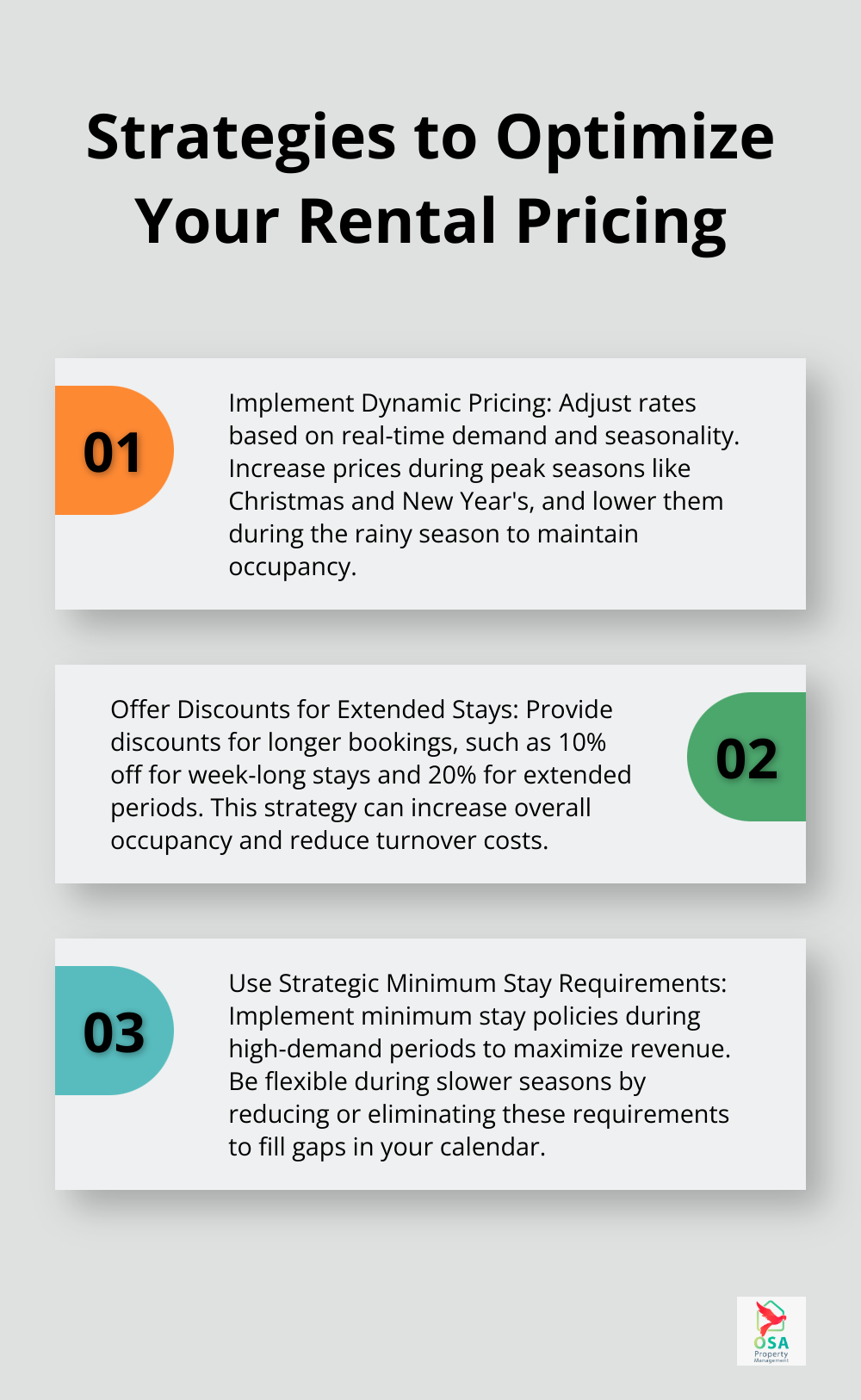At Osa Property Management, we know that setting the right rental pricing in Costa Rica can make or break your investment success. The Costa Rican rental market is dynamic, with unique factors influencing demand and rates across different regions and seasons.
In this post, we’ll share our expert insights on maximizing your property’s occupancy through strategic pricing. We’ll explore key considerations, from location and amenities to seasonal trends and local events, helping you make informed decisions for your Costa Rica rental.
What Drives Costa Rica’s Rental Market?
Costa Rica’s rental market thrives on a complex interplay of factors that property owners must grasp to optimize their investments. Location, seasonality, and property types form the backbone of rental success in this tropical paradise.
Prime Locations and Their Appeal
Costa Rica’s most coveted destinations significantly influence rental demand and pricing. The Pacific Coast, including Manuel Antonio and Jaco, consistently draws tourists with its breathtaking beaches and national parks. The Costa Rica Tourism Board reported a 15% increase in visitors to these areas in 2024 compared to the previous year.
Inland destinations like Arenal and Monteverde, famous for their lush rainforests and adventure activities, command premium rates during the dry season. Properties in these areas can charge up to 30% more from December to April (based on recent market data).
Seasonal Swings in Demand
Costa Rica experiences two distinct seasons that dramatically affect rental pricing:
- High Season (December to April): This dry period sees the highest influx of tourists. Rental rates increase by 20-30% during these months.
- Green Season (May to November): While traditionally slower, this period attracts budget-conscious travelers and those seeking lush landscapes. Property owners often offer slight discounts or value-added services to maintain occupancy.

Property Types and Their Performance
Different property types cater to varied traveler preferences and budgets:
- Beachfront Condos: These units, especially in areas like Jaco and Guanacaste, command the highest nightly rates (often ranging from $150 to $500 depending on luxury level and season).
- Jungle Villas: Popular in areas like Manuel Antonio, these properties offer unique experiences and can fetch $200 to $1000 per night, with occupancy rates averaging 70% during peak seasons.
- Mountain Retreats: In regions like Atenas or Escazú, these properties appeal to long-term renters and retirees, with monthly rates ranging from $800 to $3000.
Impact of Local Events and Festivals
Costa Rica’s vibrant culture and numerous events significantly impact rental demand. The Envision Festival in Uvita, for example, attracts thousands of visitors annually, causing a spike in rental prices and occupancy rates in the surrounding areas. Property owners who align their pricing strategies with these events often see substantial increases in their rental income.
Understanding these market dynamics proves essential for setting competitive rates. A thorough analysis of these trends helps property owners optimize their pricing strategies and maximize returns on their Costa Rica rentals. As we move forward, we’ll explore the specific factors that influence rental pricing in more detail.
What Drives Rental Pricing in Costa Rica?
At Osa Property Management, we’ve observed various factors that shape rental pricing in Costa Rica. Property owners who want to maximize their returns must understand these elements.

Location: The Prime Mover
Location remains the most significant factor in determining rental rates. Properties near popular beaches like Manuel Antonio or Jaco can command higher prices than similar properties just a few kilometers inland. A beachfront condo in Jaco might rent for more than a similar unit 2 km from the beach.
Proximity to attractions also plays a vital role. Rentals within walking distance of national parks, like Manuel Antonio National Park, often see higher occupancy rates compared to those requiring transportation. This proximity allows owners to charge premium rates, especially during peak wildlife viewing seasons.
Amenities: The Deal Makers
Unique features and amenities can significantly boost a property’s appeal and justify higher rates. Properties with private pools can charge more than those without. A study showed that Costa Rica rentals with hot tubs saw an increase in bookings and could command higher rates per night.
High-speed internet has become non-negotiable for many travelers, especially with the rise of digital nomads. Properties offering reliable, fast internet connections can see an increase in bookings (particularly for longer stays).
Local Events: The Demand Drivers
Costa Rica’s vibrant event calendar can dramatically impact rental demand and pricing. The Envision Festival in Uvita sees rental prices in the area spike during the event week. Similarly, the Costa Rica International Film Festival in San José can drive up demand for urban rentals during its run.
Property owners who stay informed about local events and adjust their pricing accordingly can significantly boost their annual revenue. Some owners increase their yearly income by implementing event-based pricing strategies.
Competition: The Reality Check
Analyzing local competition is essential for setting competitive rates. In popular areas like Tamarindo, where the market is saturated, pricing below similar properties can lead to an increase in bookings. However, in less competitive markets like Ojochal, premium pricing for unique properties can still attract high-end renters.
Tools like AirDNA and PriceLabs provide valuable insights into local market rates and occupancy trends. These tools help property owners fine-tune their pricing strategies to stay competitive while maximizing revenue.
Understanding these factors allows property owners to optimize their rental pricing for maximum occupancy and profitability in Costa Rica’s dynamic market. The next section will explore specific strategies to implement these insights effectively.
How to Optimize Your Rental Pricing
At Osa Property Management, we’ve refined our pricing strategies through years of experience in Costa Rica’s rental market. Successful pricing requires responsiveness to market conditions and guest preferences, not just setting a flat rate.

Implement Dynamic Pricing
Dynamic pricing transforms the Costa Rica rental market. This strategy adjusts rates based on real-time demand and seasonality. During peak seasons like Christmas and New Year’s, properties can command higher rates than off-season prices. In the rainy season (May to November), lowering rates helps maintain occupancy levels.
To effectively use dynamic pricing, monitor local events and holidays. Adjusting your prices for these events can significantly boost your annual revenue.
Offer Discounts for Extended Stays
Providing discounts for longer stays can increase your overall occupancy and revenue. Consider a 10% discount for stays of a week or longer, and 20% for extended periods. This strategy boosts income and reduces turnover costs associated with frequent guest changes.
Create special packages for long-term renters or digital nomads. A monthly rate lower than the nightly rate multiplied by 30 can attract these valuable guests.
Use Strategic Minimum Stay Requirements
Minimum stay requirements during peak seasons can maximize your revenue and reduce operational costs. For high-demand periods, a minimum stay requirement can increase your overall income compared to shorter bookings.
Flexibility with this policy during slower periods is key. In the low season, reducing or eliminating minimum stay requirements can fill gaps in your calendar. A strong majority (75.0%) of the Sabanilla Airbnb data shows acceptance of very short stays (1-2 nights), indicating a dynamic, high-turnover market.
Leverage Pricing Tools
Utilize pricing tools and software for data-driven decisions. These tools analyze market trends, competitor rates, and demand patterns to suggest optimal pricing strategies. They can automate price adjustments based on real-time data, saving time and maximizing revenue potential.
Monitor and Adjust Regularly
The rental market changes rapidly. Regular monitoring and adjustment of your pricing strategy is essential. Try to review your rates at least monthly, if not weekly during peak seasons. This proactive approach allows you to capitalize on market shifts and maintain competitive pricing.
Final Thoughts
Rental pricing in Costa Rica’s dynamic market demands constant attention, market awareness, and strategic thinking. Property owners must implement dynamic pricing, offer discounts for extended stays, and use minimum stay requirements wisely to maximize occupancy rates and revenue potential. Regular monitoring and adjustment of pricing strategies will help owners stay competitive and capitalize on market shifts.
The Costa Rica rental market offers unique opportunities and challenges, influenced by seasonal fluctuations, local events, and varying property types. Successful property owners understand these nuances and adapt their strategies accordingly (recognizing that pricing requires continual refinement and optimization). They know that a set-and-forget approach to pricing will not yield optimal results in this ever-changing landscape.
Osa Property Management understands the intricacies of rental pricing in Costa Rica. Our team of experts can help property owners achieve their financial goals through comprehensive management services, including strategic pricing assistance, marketing, and ongoing market analysis. We invite you to partner with us and leverage our deep market knowledge and proven strategies for your Costa Rica investment success.

